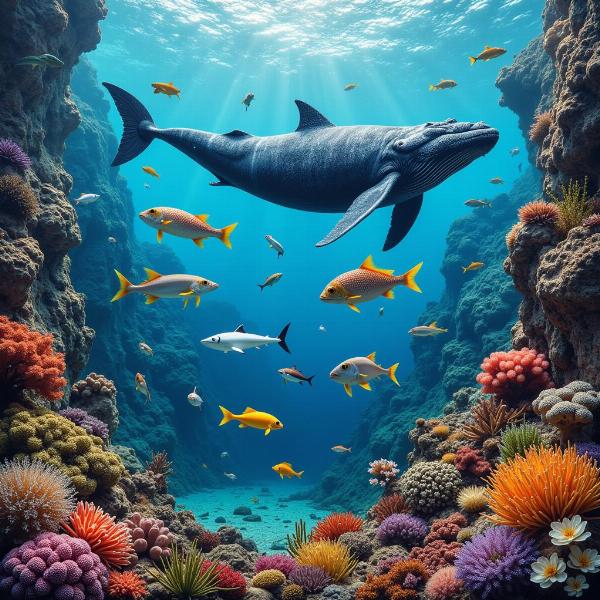Aquatic animals, a fascinating group of creatures residing in the water bodies of our planet, are integral to the ecological balance. Understanding their meaning in Hindi, “जलचर जीव” (jalachar jeev), opens a window into the rich biodiversity of India’s aquatic ecosystems. This term encompasses a wide array of life, from microscopic organisms to massive whales, all adapted to thrive in diverse aquatic environments. Whether you’re a student, a nature enthusiast, or simply curious, understanding the Hindi terminology for aquatic animals enriches your appreciation of these incredible beings.
Exploring the World of जलचर जीव (Aquatic Animals)
“जलचर” (jalachar), meaning “aquatic” or “water-dwelling,” perfectly describes the habitat of these creatures. “जीव” (jeev) translates to “creature” or “living being.” Together, these words paint a vivid picture of life beneath the surface. The term covers both freshwater and saltwater inhabitants, highlighting the diversity within the aquatic realm. India, with its vast network of rivers, lakes, and coastal regions, boasts a rich tapestry of aquatic life, making the understanding of “जलचर जीव” crucial for appreciating its natural heritage. Think of the vibrant coral reefs teeming with colorful fish, the serene rivers where dolphins gracefully swim, or the mysterious depths of the ocean harboring unknown species. Each aquatic environment harbors unique species with distinct adaptations.
 Diversity of Aquatic Animals
Diversity of Aquatic Animals
Categorizing Aquatic Animals: विभिन्न प्रकार के जलचर जीव
Aquatic animals are broadly categorized based on their primary habitat: freshwater (मीठे पानी के जीव – mithe pani ke jeev), saltwater (खारे पानी के जीव – khare pani ke jeev), and brackish water (खारे और मीठे पानी के जीव – khare aur mithe pani ke jeev). Within these broad categories, we encounter diverse groups like fish (मछली – machhli), amphibians (उभयचर – ubhaychar), reptiles (सरीसृप – sarisrup), mammals (स्तनधारी – stanadhri), and invertebrates (अकशेरुकी – akasheruki). Each group plays a specific role in maintaining the ecological balance of its respective environment.
Understanding Specific Terms: विशिष्ट शब्दों को समझना
Learning specific terms for different types of aquatic animals adds depth to your understanding. For instance, “न्यूट्स” (newts meaning in hindi) refers to a specific type of salamander, while “सीलेन्टेरेटा” (coelenterata meaning in hindi) encompasses a group of aquatic invertebrates like jellyfish and corals. These specific terms provide greater precision when discussing aquatic life.
The Importance of Aquatic Animals: जलचर जीवों का महत्व
Aquatic animals are crucial for maintaining the health of our planet. They play a vital role in the food chain, nutrient cycling, and oxygen production. Understanding their role in these intricate ecological processes highlights the interconnectedness of life on Earth. Furthermore, many aquatic species have cultural and economic significance, providing livelihoods for communities across the globe. The study of “जलचर जीव” is not merely about learning Hindi vocabulary; it’s about understanding and appreciating the intricate web of life that sustains us.
What is the Hindi Meaning of Marine? समुद्री का हिंदी अर्थ क्या है?
The Hindi meaning of “marine” is “समुद्री” (samudri), which specifically refers to organisms that live in saltwater environments like oceans and seas. It’s a crucial term when discussing the vast biodiversity found in these ecosystems. Learning the nuances of such terms helps us appreciate the specific adaptations of marine organisms. hindi meaning of marine provides a deeper understanding of this fascinating world.
Conclusion: निष्कर्ष
Understanding “aquatic animals meaning in Hindi” as “जलचर जीव” opens up a world of fascinating creatures and ecosystems. From the smallest plankton to the largest whales, these creatures play essential roles in the global ecosystem. By expanding our vocabulary and knowledge of specific terms like “क्लोरोफाइसी” (chlorophyceae meaning in hindi) and “अमोनोटेलिक” (ammonotelic meaning in hindi), we can better appreciate the incredible diversity of aquatic life.
FAQ
-
What are some common examples of जलचर जीव? Some common examples include fish, dolphins, whales, crabs, and jellyfish.
-
Why is it important to understand the Hindi meaning of aquatic animals? It helps us appreciate India’s rich aquatic biodiversity and communicate effectively about these creatures.
-
What are the different types of aquatic habitats? The main types are freshwater, saltwater, and brackish water.
-
Where can I learn more about specific aquatic animals in Hindi? Resources like Meaning-Hindi.in offer detailed information on various species and terminology.
-
How can I contribute to the conservation of aquatic animals? Reducing pollution, supporting sustainable fishing practices, and raising awareness are some key steps.
-
What is the significance of learning specific terms like “समुद्री”? Specific terms allow for more precise communication and a deeper understanding of the different aquatic environments.
-
Are all aquatic animals found in India? No, different regions have unique aquatic species depending on factors like climate and water salinity.
Meaning-Hindi.in is your one-stop solution for all your Hindi translation needs. We offer a wide range of professional translation services, including business and commercial document translation, legal and certified translation, technical and user manual translation, website and localization services, and educational and academic document translation. Our expertise also covers specialized fields, ensuring accuracy and cultural sensitivity. Contact us today for fast and reliable translation services at [email protected] or call us at +91 11-4502-7584. Meaning-Hindi.in will help you bridge the language gap effectively.